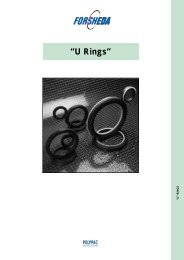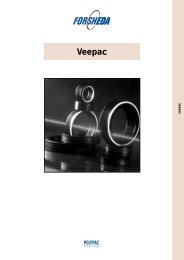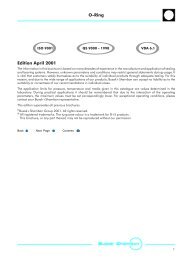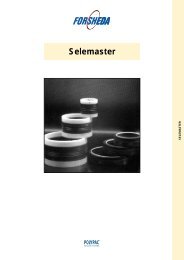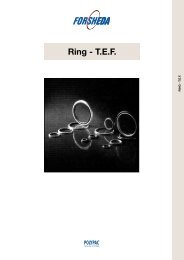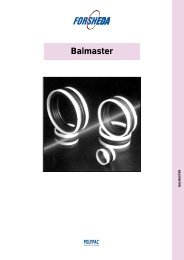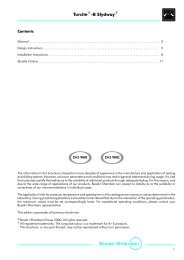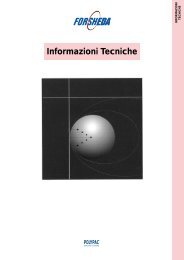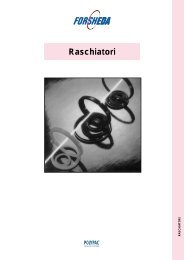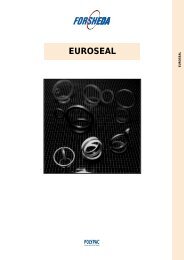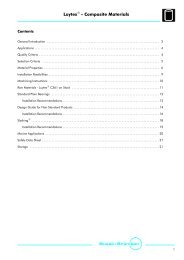Rotary Seals - Dilanda.it
Rotary Seals - Dilanda.it
Rotary Seals - Dilanda.it
Create successful ePaper yourself
Turn your PDF publications into a flip-book with our unique Google optimized e-Paper software.
<strong>Rotary</strong> Seal<br />
Radiation<br />
Precaution should be taken to protect stored articles from<br />
all sources of ionising radiation likely to cause damage to<br />
stored articles.<br />
Oxygen and ozone<br />
Where possible, elastomeric materials should be protected<br />
from circulating air by wrapping, storage in airtight<br />
containers or by other su<strong>it</strong>able means.<br />
As ozone is particularly deleterious to some elastomeric<br />
seals, storage rooms should not contain any equipment<br />
that is capable of generating ozone, such as mercury<br />
vapour lamps, high voltage electrical equipment, electric<br />
motors or other equipment which may give rise to electric<br />
sparks or silent electrical discharges. Combustion gases and<br />
organic vapour should be excluded from storage rooms<br />
alas they may give rise to ozone via photochemical<br />
processes.<br />
Deformation<br />
Elastomeric materials should, wherever possible, be stored<br />
in a relaxed cond<strong>it</strong>ion free from tension, compression or<br />
other deformation. Where articles are packed in a strainfree<br />
cond<strong>it</strong>ion they should be stored in their original<br />
packaging.<br />
Contact w<strong>it</strong>h liquid and semi-solid materials<br />
Elastomeric seals should not be allowed to come into<br />
contact w<strong>it</strong>h solvents, oils, greases or any other semi-solid<br />
materials at any time during storage, unless so packed by<br />
the manufacturer.<br />
Contact w<strong>it</strong>h metal and non-metals<br />
Direct contact w<strong>it</strong>h certain metals, e.g. manganese, iron<br />
and particularly copper and <strong>it</strong>s alloys, e.g. brass and<br />
compounds of these materials are known to have<br />
deleterious effects on some rubbers. Elastomeric seals<br />
should not be stored in contact w<strong>it</strong>h such metals.<br />
Shelf life and shelf life control<br />
The useful life of a elastomeric seals will depend to a large<br />
extent on the type of rubber. When stored under the<br />
recommended cond<strong>it</strong>ions (above sections) the below given<br />
shelf life of several materials shown below should be<br />
considered.<br />
AU, Thermoplastics<br />
NBR, HNBR, CR<br />
EPDM<br />
FKM, VMQ, FVMQ<br />
FFKM, Isolast ®<br />
Turcon ® and other PTFE<br />
4 years<br />
6 years<br />
8 years<br />
10 years<br />
18 years<br />
unlim<strong>it</strong>ed<br />
Elastomeric seals should be inspected after the given<br />
period. After this if the parts have not deterioated an<br />
extension period is possible.<br />
Rubber details and components less than 1.5 mm thick are<br />
liable to be more seriously affected by oxidation<br />
degradation even when stored in satisfactory cond<strong>it</strong>ions<br />
as recommended. Therefore they may be inspected and<br />
tested more frequently than <strong>it</strong> is mentioned above.<br />
Rubber details / seals in assembled components<br />
It is recommended that the un<strong>it</strong>s should be exercised at<br />
least every six months and that the maximum period a<br />
rubber detail be allowed to remain assembled w<strong>it</strong>hin a<br />
stored un<strong>it</strong>, w<strong>it</strong>hout inspection, be a total of the in<strong>it</strong>ial<br />
period stated above and the extension period. Naturally<br />
this will depend on the design of the un<strong>it</strong> concerned.<br />
Because of possible transfer of plasticisers or other<br />
ingredients, rubbers must not be stored in contact w<strong>it</strong>h<br />
PVC. Different rubbers should preferably be separated<br />
from each other.<br />
Cleaning<br />
Where necessary, cleaning should be carried out w<strong>it</strong>h the<br />
aid of soap and water or methylated spir<strong>it</strong>s. Water should<br />
not, however, be perm<strong>it</strong>ted to come into contact w<strong>it</strong>h<br />
fabric reinforced components, bonded seals (because of<br />
corrosion) or polyurethane rubbers. Disinfectants or other<br />
organic solvents as well as sharp-edged objects must not be<br />
used. The articles should be dried at room temperature and<br />
not placed near a source of heat.<br />
14<br />
Latest information available at www.busakshamban.com<br />
Ed<strong>it</strong>ion April 2006



